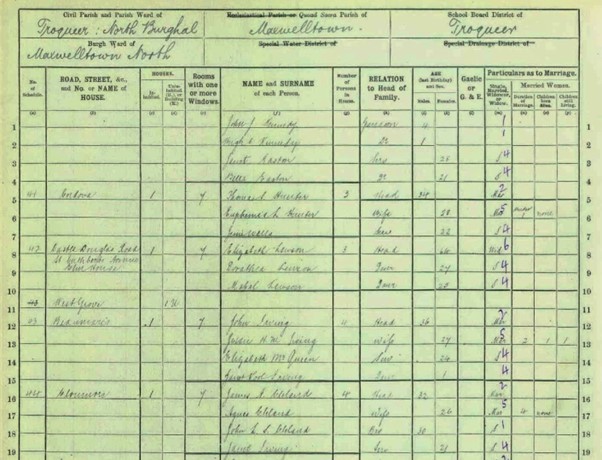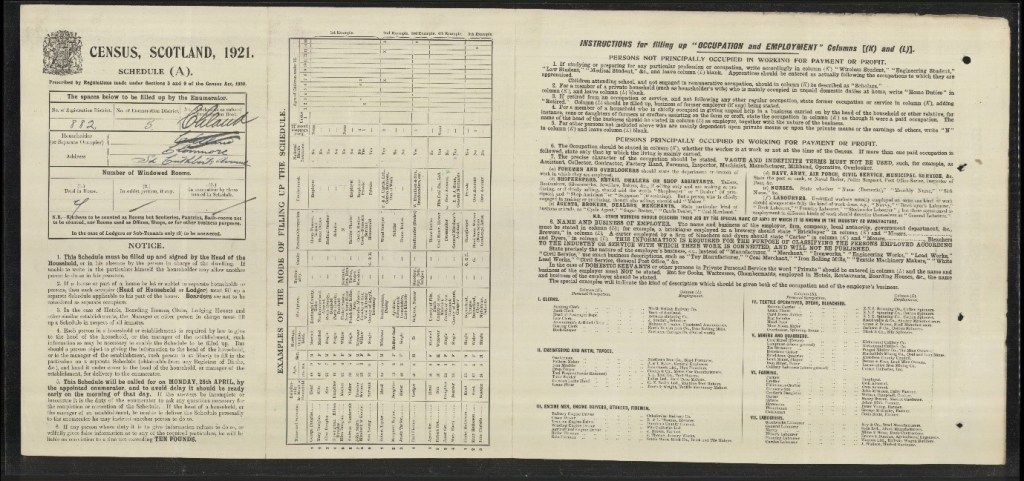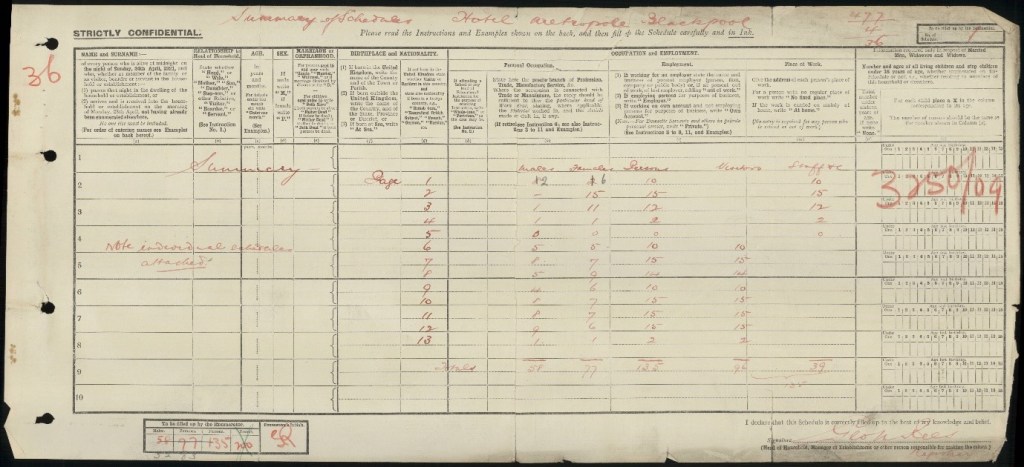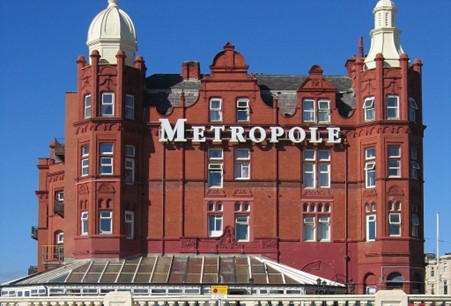The 1921 census for Scotland is now available to search and view on ScotlandsPeople and in ScotlandsPeople Centres.
Today, National Records of Scotland archivist Tessa examines a Scottish schedule preserved in the 1921 census for England and Wales which can be viewed online at Find My Past.
Background to the 1921 census
A census is the official count of every person and household in the country. There has been a census in England, Scotland and Wales every 10 years since 1801, with the exception of 1941. The 2021 census in Scotland was moved to 2022 due to the COVID-19 pandemic.
The 1921 census of the population of England, Wales and Scotland was taken on the night of Sunday 19 June 1921 from the heads of every household, institution and vessel. The census had originally been planned for the night of Sunday 24 April but was postponed by almost two months due to industrial unrest. Since the census was taken at a time of year popular for summer holidays, it shows a significant population increase for some seaside towns in England and Scotland, for example, a 64% increase in Blackpool. As a consequence, this means that individuals and families may not be where you expect to find them in the census and families may also be fragmented.
The schedules
For every census year, an enumerator delivered a form, known as a schedule, to the head of each household to complete with information of everyone who stayed in that dwelling on census night, which was always a Sunday. The schedules were collected by an enumerator a few days later and copied into enumeration books from 1841 to 1901 for England and Wales and from 1841 onwards in Scotland.

Crown copyright, National Records of Scotland, GRO6/478/3, page 1

Crown copyright, National Records of Scotland, GRO6/478/3, page 2
There were practical advantages to using the enumeration books rather than retaining the schedules, especially due to the volume of the latter. Correspondence in the records of the General Register Office concerning the continuation of the enumeration books for the use of the Registrar General, noted:
‘The great practical advantages of the use of an enumeration book are the obtaining of a record in a form usable for reference and of a reasonable bulk…If bound schedules are to be kept in place of these books a great housing difficulty presents itself, for the use of shelving space may be taken as at least ten times as great. An estimate based on the English experience of 1911 shows that some 3,000 feet of wide and deep shelving would be required for the housing of the bound schedules of a Scottish Census.’
Aside from the cost of providing shelving and accommodation for the schedules, the correspondence also highlighted that the enumeration books ‘facilitated the tabulation work of the census’ and without them would ‘little doubt result in additional clerical and other expense.’ An additional advantage was that the enumeration books helped secure ‘closer scrutiny of the schedules by the enumerators – a matter of very considerable moment.’
(The National Archives, General Register Office: Census Returns: Correspondence and Papers, 1921 Census, RG19/60, pages 87-88).
The 1921 census for England and Wales includes completed schedules from the 1921 census for Scotland. These surviving schedules are unusual. As previously mentioned, the records of the 1921 census for Scotland are the enumeration books which contain information transcribed from the household schedules as with all previous censuses back to 1841. The schedules were destroyed after the completion of work on the census.
Some Scottish schedules survived because these households were on holiday or on business in England on census night and, in England and Wales, the schedules were kept as the official record of the census for 1911 and 1921.
The Cleland family
James A Cleland and his household are enumerated in the 1911 census for Scotland at Clonmore House in Troqueer, Kirkcudbright. The house had seven rooms, each with one or more windows. James was 32 years old and the head of the household. He was married to Agnes, aged 26, and also lived with his younger brother, John L S, aged 30, and Janet Irving, their servant, aged 21. James and Agnes had been married for four years and had no children. None of the household were Gaelic speakers, a question particular to the Scottish census.

Crown copyright, National Records of Scotland, 1911/882/5, page 6
Nine years later, James is recorded in the 1920 valuation roll for Kirkbudbright county as the tenant of Clonmore, St Cuthbert’s Avenue. He was employed as a draper. The proprietor was Elizabeth Lawson and the property had an annual rateable value of £39 10s and 4d. (Equivalent to £1,148.26 in 2017 for 1920, according to The National Archives currency converter.

Crown copyright, National Records of Scotland, VR106/48, page 278
The valuation rolls do not record the depth of information found in a census record and are not a census substitute in terms of listing all people resident at a property, which is why only James is recorded.
James and his household cannot be found in the 1921 census for Scotland. However, a search for ‘James Cleland’ with a birth year of around 1877 in the index for the 1921 census for England and Wales returns the following results:

Index entry for James Arthur Cleland 1921 Census of England & Wales. Crown Copyright, Courtesy of The National Archives
As we can see from the index entry above, James Arthur Cleland was in Blackpool, a popular holiday destination, at the time of the 1921 census.
When we download the image related to this entry, the schedule is clearly marked ‘Census Scotland 1921’. This suggests that James and his family brought it with them on holiday. It includes further details about them in comparison to their entry in the 1911 census for Scotland.

Census schedule for James Arthur Cleland and family, 1921 Census of England & Wales. Crown Copyright, Courtesy of The National Archives, RG15/20792/451
James was 44 years old, from Lugar in Ayr, and was employed as a General Merchant. Agnes Weir was 36 years old, from Kirkmahoe in Dumfriesshire and was a housewife, described here as ‘Home Duties’. John Luke Scott, was 42 years old, and, like his brother, from Lugar and employed as a General Merchant. The schedule also confirms that none of the family were Gaelic speakers. It was signed by James, who was the head of the household. It is also interesting that the details are typed, suggesting that James prepared the schedule in advance of the family holiday.

Crown Copyright, Courtesy of The National Archives, RG15/20792/451
The reverse of the schedule confirms that the family’s usual residence was in Scotland at their home ‘Clonmore’ in St Cuthbert’s Avenue.
Further searching of adjacent schedules in the 1921 census for England and Wales, reveals that the Cleland family were also accompanied on their holiday by John Whan, their motor driver.

Credit: Crown Copyright, Courtesy of The National Archives, RG15/20792/58
John was aged 37, married and from Roxburgh, Castletown. He describes himself as ‘Scotch’, employed as a ‘Motor Driver’ for ‘Mr Cleland Draper’. The schedule is signed by John. There is a note in pencil, not in his hand, which reads ‘Clonmore St Cuthberts Avenue Cleland’.
A wider search of neighbouring schedules also reveals that the Cleland family and their driver, John Whan, were staying at the Hotel Metropole in Blackpool on census night. The following document is a summary of schedules for the hotel to which the individual schedules for the hotel guests, including the Cleland’s and John Whan’s were attached. These schedules would have been gathered together by the hotel manager or another member of staff. A few days later, they would have been collected by an enumerator, presumably George Rees, Registrar, who completed and signed the summary document.

Credit: Crown Copyright, Courtesy of The National Archives, RG15/20792

The Metropole Hotel, also known as the Grand Metropole Hotel, is a distinctive red brick building and is the only hotel to sit directly on the Blackpool shoreline. It opened in 1785 and is one of the two oldest hotels in Blackpool still in operation. It was modernised in 2018 and has 223 bedrooms, two restaurants and a café and is currently owned by Britannia Hotels.
Conclusion
The Cleland family’s schedule is not the only Scottish schedule preserved in the 1921 census for England and Wales. However, we hope this case study reveals how it is worthwhile to widen your search when researching your ancestors. You never know what you may find!
Acknowledgements
With grateful thanks to Audrey Collins, Family History Specialist at The National Archives (TNA), for highlighting the Cleland schedule and generously sharing related records from TNA.
Tessa Spencer
Archivist
Outreach and Learning
Sources
ScotlandsPeople: statutory registers, census returns, valuation rolls and record and research guide
As a matter of course, I always check the England and Wales Census for any Scottish family and relatives who are missing from the Scotland Census. Aside from them possibly being on holiday, I have discovered visits due to an illness or death in the family, and evidence of permanent moves or migration from Scotland to England.
LikeLike